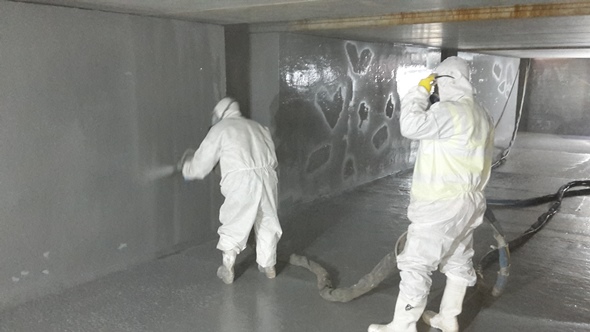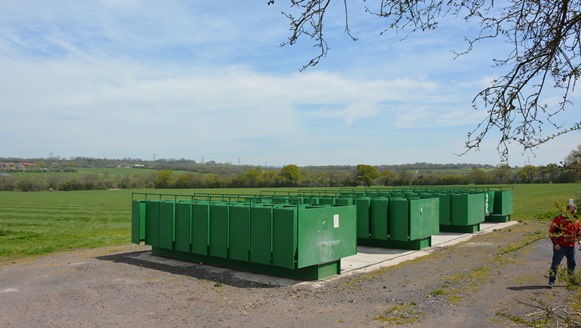The Glastonbury Festival in Somerset, England, hails 175,000 attendees and requires 50,000 support staff, not to mention seven stages and a myriad of other areas for entertainment. The 2017 show alone featured big-name talent such as Katy Perry, The Foo Fighters, and The Flaming Lips. That’s a lot of bodies in one location…and a lot of waste that comes with them.
It’s not exactly the glamorous side of music festivals, but it’s certainly a side that has to be dealt with. There are 32 septic tanks on the festival’s site, but they were cracked and leaking. That’s not the kind of encore concertgoers are usually looking for. So the venue owners called in Ultimate Coatings Ltd. to fix the problem before the festival’s 2016 kickoff. With a particularly wet winter standing in the crew’s way, could they get it done in time?
Opening Act
The opening act for the coating system on this project, just as in all other coating projects, was the surface prep. The 13-person crew from Ultimate Coatings started by pressure washing the 35,000 square feet (3,251.6 m²) of concrete block. They used 8,000-psi (55.2 MPa) power washers to remove loose concrete, old fibers, and any other debris from the area. They moved onto grinding the floors, which created a flat and profiled surface for the system to latch onto, much like a groupie to a rockstar. Debris was vacuumed and the crew moved onto concrete repair.
The crew worked on patches and other repairs using damp-tolerant epoxy and polyaspartic materials from Specialty Products, Inc. (SPI) called SPI Aspaflex Body Coat and SPI EP-90. (All products were supplied by SPI’s European distributor, SPI Performance Coatings, which also supplied the in-house contracting firm.)
Working underground, with plural-component materials, and within a confined environment, the crew needed to pay particular attention to safety. They wore breathing apparatuses and gas monitors for working in confined spaces.
Main Act
England is known for being a bit on the cloudy side, but the winter that Ultimate Coatings worked on the relining of the septic tanks was wetter than normal. According to Richard Atkinson of Ultimate Coatings, “It rained all throughout the job. This made the windows for priming and spraying the tank very small, so we had to use industrial aircraft dryers normally used to heat up jet planes to accelerate the drying process.”
The dryers, four 400,000 British Thermal Units (BTU) indirect heaters, were particularly useful while the coating system cured. However, the heaters also raised the temperature of the substrate, which meant that before the coating could be applied, cold ventilation had to be used.

Once the substrate was ready, the crew began with an epoxy primer, again SPI’s EP-90. The crew applied that layer with rollers and scuttles at 250‒400 grams per metre (8.1‒12.9 ounce per yard) thick. Because there was some pin-holing, the crew then applied a second coat of the same primer but this time with Staingard Rapide added in to address the pinholes. Sometimes a backup band is needed to get the job done right!
The crew wore full overalls, gloves, boots, and air-fed masks to apply the coatings. Then, wielding a spray gun and Reactor HXP 3 from Graco, the crew applied 1 mm (39.4 mils) of the star of the show: SPI Performance Coatings’ HT100FUB. That layer was tested visually and with a holiday detector by Elcometer. Any pinholes, holidays, or other defects that were found were then touched up with a polyurethane material called Rallithane 810. The crew finished the system with another 1-mm (39.4 mils) layer of the polyurea to create a monolithic barrier. This layer was once again tested for pinholes, but new to this layer was that the crew brought in the client for verification.
Standing Ovation
The project, which took place between February and May 2016, was completed in time for the June festival — a project that will pay off for years to come.
“As a result of our work, the festival owner has total peace of mind that the sewerage tanks are in a prime condition and waterproofed for the life of the festival,” said Marcus Lockett, managing director of SPI Performance Coatings. “Now that the tanks are no longer degrading and will last much, much longer, the owner is now looking at further building upon our work by putting his own sewage processing systems in place. This will enable sewage to be held, treated, and used on site to fertilize the farmland, and will undoubtedly bring the number of waste tanker visits to and from the local waste treatment sites down.”
For this project, the crew deserves a standing ovation!
“This was a tricky project made even more difficult by the unusually wet weather: watch the footage of the festival!” Atkinson said. “Luckily our resolve and the belief and support from Chris and his team at Glastonbury meant we worked together as a team to deliver the linings in time for the festival to go ahead.”
